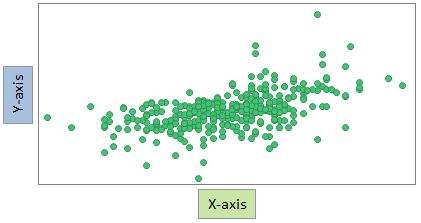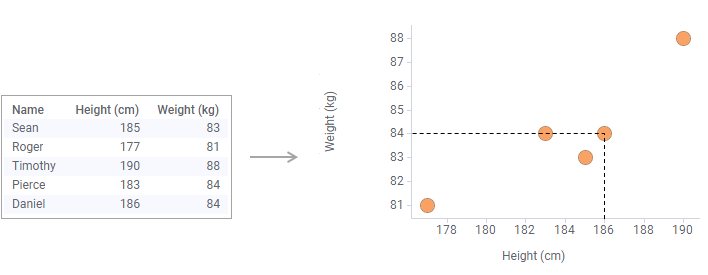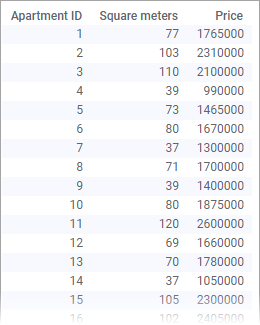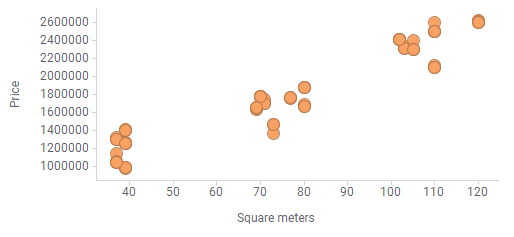Creating a scatter plot
In a scatter plot, markers are displayed in a two-dimensional coordinate system. It is useful for getting an overview of how your data is distributed across two dimensions.
About this task

By default, each row in your loaded data table is represented by a marker. The marker's position in the coordinate system is defined by the row's values in the columns selected on the X-axis and the Y-axis. For example, the marker's position for the last row in the data table below is the coordinate 186 on the X-axis, and 84 on the Y-axis.

Procedure
Examples
When visualizing data in scatter plots, you get a view of the
distribution. You may for example find that data forms groups, or that data is
more gathered.

The scatter plot can also be used to examine whether or not there is a relationship between the columns. The closer the markers are to a straight line, the stronger the relation. For example, the column values in the left-hand scatter plot below do not seem to be related, but in the right-hand scatter plot, a higher value on the X-axis seems, in general, to have a higher value on the Y-axis.


The scatter plot can also be used to examine whether or not there is a relationship between the columns. The closer the markers are to a straight line, the stronger the relation. For example, the column values in the left-hand scatter plot below do not seem to be related, but in the right-hand scatter plot, a higher value on the X-axis seems, in general, to have a higher value on the Y-axis.

To illustrate how you can get an overview of the data distribution,
the following data table is visualized in the bottom scatter plot.

The data table lists areas and prices of a number of apartments. At a quick glance, it is easy to see that the objects appear in groups.


The data table lists areas and prices of a number of apartments. At a quick glance, it is easy to see that the objects appear in groups.

- Using marker appearance to add more information
The markers in a scatter plot provide an overview of how the data is distributed across two dimensions, the X-axis and the Y-axis. If you use colors, shapes, and sizes of the markers, further information about your data can be displayed. - Using tiled markers
A special use of marker shapes in a scatter plot is the tiled markers. Tiled markers are shaped as rectangles, displayed without gaps in a grid, and any added labels are always centered. - Creating a density plot
The density plot shows how numerical data, binned into intervals, is distributed across the X-axis and Y-axis. To visualize the density, that is, visualize to which extent the markers overlap each other totally, the Color by setting is used. - Adjusting the drawing order of markers
When markers cover each other, partly or totally, it can be useful to specify an order in which the markers are drawn. Markers of certain interest can then be brought forward in the visualization, and other markers backward. - Showing directions using marker rotation in a scatter plot
Some marker shapes, for example arrows, indicate directions. If you in a scatter plot rotate such markers, you can visualize directions of motions. What you need is a column that contains values that can be interpreted as degrees.
Parent topic: Creating a visualization